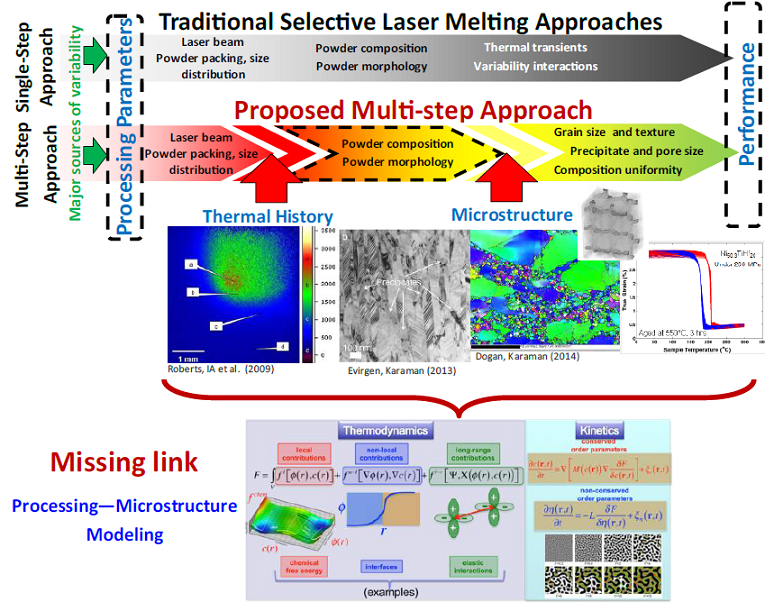Additive Manufacturing (AM) is a set of emerging manufacturing technologies with unique characteristics, such as the ability to produce parts with arbitrary complex geometries directly from a digital model, and without the need for custom and expensive tooling.
However, a number of challenges remain to be addressed before AM realizes its full potential. First is the need for better predictive models that correlate processing parameters such as energy deposition rate and scan speed to part performance. This has been a complicated task since the reported microstructures of AM fabricated alloys differs quite significantly from as-cast alloys of the same composition. These microstructural differences influences performance, and are greatly dependent on the thermal history of the part during the AM processes.
The majority of existing AM modeling efforts do not consider the evolution of the microstructure during melting, solidification and re-heating and these approaches thus lack the intermediate link, i.e. microstructure, correlating process parameters to performance. These models are also usually ignore the inherent variability in process parameters and material properties, and are incapable of identifying key factors that influence variability in performance. The consensus among the AM community is that low repeatability of metal AM parts represents the ‘Achilles Heel’ that hampers the widespread adoption of AM as a viable manufacturing method. Quantifying, and subsequently reducing, variability in AM parts is a vital requirement in the process of material and part certification.
This project presents an experimental and physics-based modelling framework to predict the microstructure evolution of NiTi Shape Memory Alloys (SMAs) during Selective Laser Melting (SLM) process, with associated uncertainties, and enable the potential verification and quantification of sources that contribute to the overall variability in performance. Once microstructural evolution can be predicted as a function of AM process parameters, it would be possible to utilize the existing widespread knowledge base and modeling tools on microstructure-property/performance relationships to further predict the performance of the parts made out of the aforementioned materials, closing the missing link connecting processing parameters to performance.
As a part of this project, we focus on phase field modeling of microstructure evolution, particularly the rapid solidification of NiTi Shape Memory Alloys (SMAs) during Selective Laser Melting (SLM) process. A brief description of the proposed approach is described below:
- A three-dimensional finite element model which uses SLM process parameters as inputs will be developed to predict the thermal history of the part. This time and position dependent thermal history will be used to estimate the cooling rates and thermal gradients.
- A non-isothermal multi-phase field modeling framework will be developed based on the phase-field model with finite interface dissipation approach suggested by Zhang and Steinbach [1]. The predicted thermal history will be used as boundary conditions to the phase-field model to predict the microstructure evolution during SLM.
- The further evolution of the solidified material subject to reheating by subsequent beam passes will be investigated through the same multi-phase field framework.
- The predicted microstructures will be compared against experimental characterization in order to adjust model parameters difficult to measure (including interfacial energies) as well as to validate overall modeling approach.

